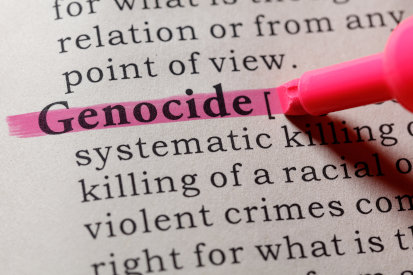The word “genocide” consists of the Greek prefix genos, meaning race or tribe, and the Latin suffix cide, meaning killing. Broadly speaking, it is a term used to refer to targeted actions aimed at the destruction of particular groups of people.
Genocide was first first recognised as a crime under international law in 1946 by the United Nations General Assembly (A/RES/96-I). It was codified as an independent crime in the 1948 Convention on the Prevention and Punishment of the Crime of Genocide (the Genocide Convention).
On its website, the United Nations provides insight into the elements of this crime, and clarifies who is bound by the relevant legislation.
Which countries are bound by the Genocide Convention?
The Convention has been ratified by 149 States (as of January 2018). The International Court of Justice (ICJ) states that whether or not a country has ratified the Convention, it is legally bound by the principle that genocide is a crime prohibited under international law.
Defining genocide
Genocide is defined in Article II of the Genocide Convention:
In the present Convention, genocide means any of the following acts committed with intent to destroy, in whole or in part, a national, ethnical, racial or religious group, as such:
- Killing members of the group;
- Causing serious bodily or mental harm to members of the group;
- Deliberately inflicting on the group conditions of life calculated to bring about its physical destruction in whole or in part;
- Imposing measures intended to prevent births within the group;
- Forcibly transferring children of the group to another group.
This definition was negotiated amongst the United Nations Member States in 1948 at the time of drafting the Convention, and is defined in the same terms in the Rome Statute of the International Criminal Court (Article 6).
Elements of the crime
The above definition of Genocide effectively contains two elements:
- A mental element: the “intent to destroy, in whole or in part, a national, ethnical, racial or religious group, as such”; and
- A physical element: which includes one of the five acts outlined above (e.g. killing members of the group)
The United Nations states that “intent is the most difficult element to determine” and that “cultural destruction does not suffice, nor does an intention to simply disperse a group.” To constitute genocide, is must be proven that the perpetrator/s intended to physically destroy a national, ethnical, racial or religious group. Although not contained in the above definition, case law has associated intent with the existence of a State or organisational plan/policy.
Other key elements include that the target must be the group, as opposed to its members as individuals, and that the victims are deliberately (not randomly) targeted.
It is worth noting that genocide can also be committed against only a part of the group, as long as that part is identifiable (e.g. within a specific geographical area) and “substantial.”



